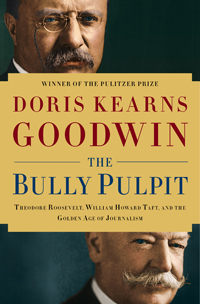Rage Against the Machines
Doris Kearns Goodwin explores politics and journalism during the progressive era
In 1912, former president Theodore Roosevelt challenged the incumbent William Howard Taft for the Republican nomination. Things quickly became ugly. As Doris Kearns Goodwin explains in The Bully Pulpit: Theodore Roosevelt, William Howard Taft, and the Golden Age of Journalism, the Roosevelt and Taft delegates clashed repeatedly. In Bay City, Michigan, police used their clubs to break up a riot. Explosions rocked another meeting. In Guthrie, Oklahoma, writes Goodwin, “a Roosevelt supporter held a loaded gun to the head of the chairman of Taft’s delegation. He wanted to be fully prepared, he declared, in case ‘any chicanery’ occurred.” The violence was certainly unusual, but the truly remarkable thing about these events is that Taft and Roosevelt had been best friends and leaders of the reform wing of the Republican Party. They had devoted their careers to protecting Abraham Lincoln’s ideal of government of, by, and for the people. How two powerful, close allies became bitter enemies is one of the great American stories and an apt subject for Goodwin’s Pulitzer Prize-winning talents.
 It has been eight years since Goodwin published Team of Rivals, her influential, bestselling account of Abraham Lincoln’s “political genius.” The years were not wasted. Her research has produced an enlightening account of not one but two of America’s most important peacetime presidents and the social and political revolution they engineered. Like its predecessor, The Bully Pulpit is a large volume full of historical detail. This is as it should be. History is usually as complex and full of subtlety as the men and women who make it, and Goodwin does not scrimp in presenting the complicated, turn-of-the-century world that Roosevelt, Taft, and crusading reporters worked to change.
It has been eight years since Goodwin published Team of Rivals, her influential, bestselling account of Abraham Lincoln’s “political genius.” The years were not wasted. Her research has produced an enlightening account of not one but two of America’s most important peacetime presidents and the social and political revolution they engineered. Like its predecessor, The Bully Pulpit is a large volume full of historical detail. This is as it should be. History is usually as complex and full of subtlety as the men and women who make it, and Goodwin does not scrimp in presenting the complicated, turn-of-the-century world that Roosevelt, Taft, and crusading reporters worked to change.
The ills of the nation were great by the end of the nineteenth century. Entrenched political machines bred and nurtured corruption while gigantic industrial trusts both delivered wonders of technology and crushed the dreams of the workers. “A mood of rebellion began to spread among the laboring class,” Goodwin writes. “The late eighties and nineties witnessed an unprecedented number of violent strikes in the nation’s factories, mines, and railroads.” Some politicians grew fearful of outright revolution. Reform had begun under James Garfield and his successor, Chester Arthur, but little real progress had been made. The combination of crooked politics and moneyed special interests slowed the kind of change that was needed to avert catastrophe.
 Roosevelt, a son of wealth and privilege, inherited a philanthropic attitude from his father. When he entered politics, the young man realized that if the benefits of capitalism—which he never doubted—were to be enjoyed, they must be enjoyed by all. He believed that the system had to be saved from its own excesses or it would be destroyed by socialists and anarchists. Taft, another son of the upper class, also came to reform as a result of his parents’ dedication to social causes. The two men met while serving in the administration of Benjamin Harrison, Roosevelt as head of the Civil Service Commission and Taft as solicitor general. “In William Howard Taft,” notes Goodwin, “Roosevelt recognized a staunch comrade, a steadfast advocate of advancement due not to cronyism but to competence.” The two were soon inseparable, allied against the forces that represented the old guard—the men in Congress, state houses, and city councils who received largesse from corporations, maintained power through graft, and voted against any law that would alter the status quo. With such powerful enemies, both men needed strong friends.
Roosevelt, a son of wealth and privilege, inherited a philanthropic attitude from his father. When he entered politics, the young man realized that if the benefits of capitalism—which he never doubted—were to be enjoyed, they must be enjoyed by all. He believed that the system had to be saved from its own excesses or it would be destroyed by socialists and anarchists. Taft, another son of the upper class, also came to reform as a result of his parents’ dedication to social causes. The two men met while serving in the administration of Benjamin Harrison, Roosevelt as head of the Civil Service Commission and Taft as solicitor general. “In William Howard Taft,” notes Goodwin, “Roosevelt recognized a staunch comrade, a steadfast advocate of advancement due not to cronyism but to competence.” The two were soon inseparable, allied against the forces that represented the old guard—the men in Congress, state houses, and city councils who received largesse from corporations, maintained power through graft, and voted against any law that would alter the status quo. With such powerful enemies, both men needed strong friends.
The full title of The Bully Pulpit includes the phrase “the golden age of journalism,” and in this aspect of the story Goodwin reveals the reformers’ not-so-secret weapon. While serving in the New York State Assembly as one of its youngest members, Roosevelt recognized the limits of his influence: “Good legislation could only be passed,” Goodwin writes, “if the conscience of the public was awakened, exerting pressure on the passive majority. Immediately Roosevelt understood that the most effective means of circumventing the machines and transforming popular sentiment was to establish a good rapport with the press corps.”
Fortunately for the country, Roosevelt excelled at giving the press good copy. Almost anyone who ever knew him, whether as friend or enemy, agreed that he was not so much a man as a force of nature. Constantly in motion, forever thinking and reading and writing, he was so colorful and dominant a personality that many people, including reporters, simply couldn’t resist the desire to be in his presence. When literary entrepreneur Samuel S. McClure founded his namesake magazine and assembled a crack team of investigative journalists, a mutually beneficial relationship took hold.
McClure’s was, by the turn of the century, one of America’s most influential journals. The editorial stance was progressive, but absolute impartiality in reporting was demanded. In an age dominated by yellow journalism, the high standards of McClure and his stable of men and women reporters were a breath of fresh air. Goodwin points to a single edition as the pinnacle of their art, an issue that included exposés of Standard Oil, the mayor of Minneapolis, and corrupt labor leaders. “The January 1903 issue sold out within days,” she writes, “faster than any previous issue. The revelatory articles became a leading topic of conversation in cities and towns across the country.” One of the results was to put now-president Roosevelt’s reform agenda back on track. He later denounced many reporters as mere “muckrakers,” but he provided access, source material, and even pre-publication reviews to several, including McClure’s people. By modern standards it was an unacceptably close relationship, but it allowed Roosevelt and his allies to make changes unlike any that had ever been seen.
When Roosevelt retired from the presidency in 1908, he helped his secretary of war and best friend, Taft, win the White House. Taft continued the reform movement, but the two men, once of the same mind, were very different personalities. Taft, brilliant and judicious, was immediately loved by nearly everyone who met him but was also quieter than Roosevelt, non-confrontational, and kept the press at arm’s length. He approached problems differently, and it was perhaps inevitable that there would be disagreements. Roosevelt believed that Taft was too accommodating to the old guard, and by 1912 there was an open break. Failing in his tumultuous bid for the Republican nomination, Roosevelt formed the National Progressive Party—known commonly as the Bull Moose Party—dooming both him and Taft to defeat at the hands of Democrat Woodrow Wilson.
Nevertheless, their collaboration had been a grand success. Goodwin concludes, “There was a time, at the height of their careers, when Theodore Roosevelt and William Howard Taft stood shoulder to shoulder as they charted a different role for the U.S. government that would fundamentally enlarge the bounds of economic opportunity and social justice.” In The Bully Pulpit, Goodwin has reminded the nation of what can be accomplished by men and women united in good intent. A timely reminder indeed.
[To read Chapter 16’s earlier interview with Doris Kearns Goodwin, click here.]
Doris Kearns Goodwin will discuss The Bully Pulpit: Theodore Roosevelt, William Howard Taft, and the Golden Age of Journalism as part of the Salon@615 series in the Paschall Theater at Montgomery Bell Academy in Nashville on December 12, 2013, at 6:15 pm.


